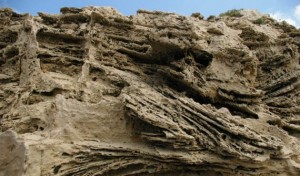Desert winds continually rework the sands on their surface, shifting grains up the stoss side of a dune to pile the sand higher… until the pile gets too steep and collapses under its own weight. This slipping of material along the front of the dune, allows it to move forward and migrate. The movement of the sand grains up and over the crest of the dunes is recorded in the internal structure of the dunes. Relatively thin layers of sediment which are seen to be at an angle with the dominant layering in the unit are known as cross-bedding and are the hallmark of a migrating dune.
Cross-bedding can be generated by water or wind, all you need is a current that will transport sand over sediments. Large scale cross-bedding helps identify ancient dunes, as it is most often associated with flow travelling in a single direction resulting in the forward movement of dunes.
Dunes can form in a number of environments: in river channels, on beaches and of course deserts too. Regardless of where they form, to continue to migrate forward they require a constant supply of sand. If that supply dies down and eventually stops the dunes stop travelling. In time, the layers of grains weld together to form lithified rocks which preserve the ancient structure of the dunes.
The picture shows a section of fossil dunes with the typical cross bedding internal structure that allows visual identification of this aeolian feature.

“Fossil dune” by Jorge Mataix-Solera. This picture was taken during a research trip near Haifa, Israel, in 2008 and is distributed by the EGU under a Creative Commons licence.
We are grateful to João Trabucho for helping us improve an earlier version of this blog post.
Imaggeo is the EGU’s open access geosciences image repository. Photos uploaded to Imaggeo can be used by scientists, the press and the public provided the original author is credited. Photographers also retain full rights of use, as Imaggeo images are licensed and distributed by the EGU under a Creative Commons licence. You can submit your photos here.
